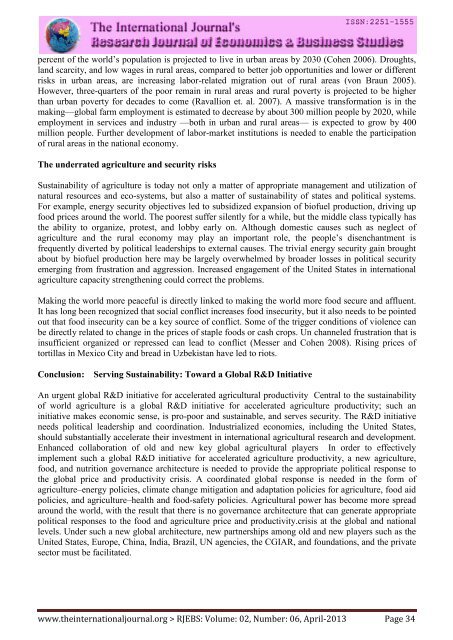Research Journal of Economics & Business Studies - RJEBS - The ...
Research Journal of Economics & Business Studies - RJEBS - The ...
Research Journal of Economics & Business Studies - RJEBS - The ...
- No tags were found...
You also want an ePaper? Increase the reach of your titles
YUMPU automatically turns print PDFs into web optimized ePapers that Google loves.
percent <strong>of</strong> the world’s population is projected to live in urban areas by 2030 (Cohen 2006). Droughts,<br />
land scarcity, and low wages in rural areas, compared to better job opportunities and lower or different<br />
risks in urban areas, are increasing labor-related migration out <strong>of</strong> rural areas (von Braun 2005).<br />
However, three-quarters <strong>of</strong> the poor remain in rural areas and rural poverty is projected to be higher<br />
than urban poverty for decades to come (Ravallion et. al. 2007). A massive transformation is in the<br />
making—global farm employment is estimated to decrease by about 300 million people by 2020, while<br />
employment in services and industry —both in urban and rural areas— is expected to grow by 400<br />
million people. Further development <strong>of</strong> labor-market institutions is needed to enable the participation<br />
<strong>of</strong> rural areas in the national economy.<br />
<strong>The</strong> underrated agriculture and security risks<br />
Sustainability <strong>of</strong> agriculture is today not only a matter <strong>of</strong> appropriate management and utilization <strong>of</strong><br />
natural resources and eco-systems, but also a matter <strong>of</strong> sustainability <strong>of</strong> states and political systems.<br />
For example, energy security objectives led to subsidized expansion <strong>of</strong> bi<strong>of</strong>uel production, driving up<br />
food prices around the world. <strong>The</strong> poorest suffer silently for a while, but the middle class typically has<br />
the ability to organize, protest, and lobby early on. Although domestic causes such as neglect <strong>of</strong><br />
agriculture and the rural economy may play an important role, the people’s disenchantment is<br />
frequently diverted by political leaderships to external causes. <strong>The</strong> trivial energy security gain brought<br />
about by bi<strong>of</strong>uel production here may be largely overwhelmed by broader losses in political security<br />
emerging from frustration and aggression. Increased engagement <strong>of</strong> the United States in international<br />
agriculture capacity strengthening could correct the problems.<br />
Making the world more peaceful is directly linked to making the world more food secure and affluent.<br />
It has long been recognized that social conflict increases food insecurity, but it also needs to be pointed<br />
out that food insecurity can be a key source <strong>of</strong> conflict. Some <strong>of</strong> the trigger conditions <strong>of</strong> violence can<br />
be directly related to change in the prices <strong>of</strong> staple foods or cash crops. Un channeled frustration that is<br />
insufficient organized or repressed can lead to conflict (Messer and Cohen 2008). Rising prices <strong>of</strong><br />
tortillas in Mexico City and bread in Uzbekistan have led to riots.<br />
Conclusion:<br />
Serving Sustainability: Toward a Global R&D Initiative<br />
An urgent global R&D initiative for accelerated agricultural productivity Central to the sustainability<br />
<strong>of</strong> world agriculture is a global R&D initiative for accelerated agriculture productivity; such an<br />
initiative makes economic sense, is pro-poor and sustainable, and serves security. <strong>The</strong> R&D initiative<br />
needs political leadership and coordination. Industrialized economies, including the United States,<br />
should substantially accelerate their investment in international agricultural research and development.<br />
Enhanced collaboration <strong>of</strong> old and new key global agricultural players In order to effectively<br />
implement such a global R&D initiative for accelerated agriculture productivity, a new agriculture,<br />
food, and nutrition governance architecture is needed to provide the appropriate political response to<br />
the global price and productivity crisis. A coordinated global response is needed in the form <strong>of</strong><br />
agriculture–energy policies, climate change mitigation and adaptation policies for agriculture, food aid<br />
policies, and agriculture–health and food-safety policies. Agricultural power has become more spread<br />
around the world, with the result that there is no governance architecture that can generate appropriate<br />
political responses to the food and agriculture price and productivity.crisis at the global and national<br />
levels. Under such a new global architecture, new partnerships among old and new players such as the<br />
United States, Europe, China, India, Brazil, UN agencies, the CGIAR, and foundations, and the private<br />
sector must be facilitated.<br />
www.theinternationaljournal.org > <strong>RJEBS</strong>: Volume: 02, Number: 06, April-2013 Page 34

















